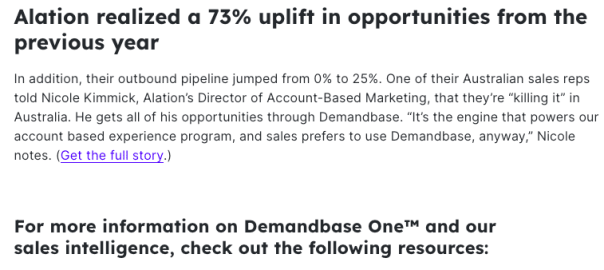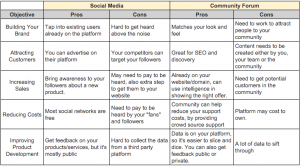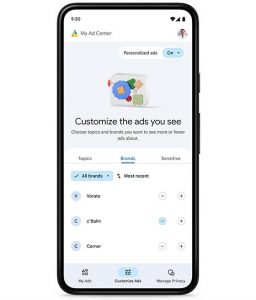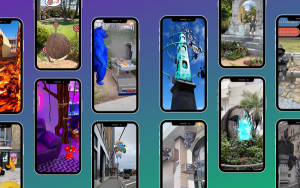Learn how to use effective CTAs in your content and email marketing for a seamless customer journey.
Imagine this.
You walk into Home Depot to buy a rake because you need to do some yard work and then decide to browse the aisles to get ideas for your dream kitchen (that you just started dreaming about and don’t have the time or budget for yet). You glance through the pre-built setups to get a sense of your style and learn what options are available.
As you’re walking away, rake in hand, a sales associate stops you and asks you to sign up today for a free home consultation to start your dream kitchen immediately and the option to sign up for a payment plan.
You’re immediately struck with anxiety and fear because you didn’t intend to do this today. You were simply browsing and finding out the information available to you so you can decide down the road.
You leave the store feeling rushed and like you’re just a number. You do get your dream kitchen two years later but from Lowe’s.
That sounds like a rough experience, right? Your customers feel this way when you put a demo CTA (call to action) at the end of every content you distribute.
They may have landed on your site to learn more about marketing automation software and are nowhere near the final stretch to the demo request. And when they are ready, they’ll remember that experience and search for other options (aka your competition).
This article explores the importance of a smooth customer journey for readers and explains how a more personalized marketing approach can help you achieve it.
Key takeaways:
- Understanding the three marketing funnel stages is crucial for creating a smooth user journey.
- Incorporating both hard and soft CTAs into your content is essential.
- Email marketing is a powerful tool for nurturing leads.
- Leading readers down the marketing funnel naturally is crucial for creating a seamless user journey and boosting conversions.
Understanding the marketing funnel
Let’s talk about the marketing funnel. It’s the journey that potential customers take from first hearing about your brand to purchasing. There are three stages to this funnel:
- Awareness.
- Consideration.
- Decision.
Awareness
At the awareness stage, you want to create content, like blogs that educate your audience on the benefits of your product or service without being too salesy. An active blog is one of the most favored ways to share content, with 79% of companies using it reporting a positive ROI ROI. Within your blog, you can add CTAs to things like newsletters, social media channels and other engagement-focused CTAs.
Lavender.AI does this throughout their blog, guiding readers to more relevant content after reading the article, naturally moving them through the funnel. No demo. No hard pitch.
Consideration
In the consideration stage, potential customers are weighing up their options, so you must provide detailed information to help them make an informed decision. This is the perfect time to offer additional resources like white papers and case studies to help build trust and showcase your expertise.
In the example below, Demandbase ends their article with social proof — inspiring readers to read a case study about the topic from the article, giving context and value to the information.
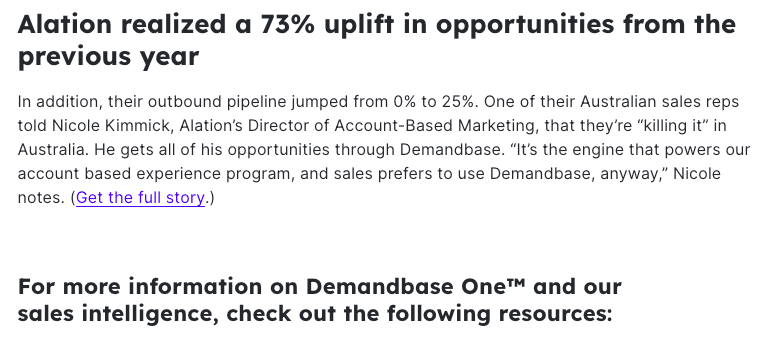
Decision
Finally, in the decision stage, you want to make it easy for potential customers to convert without being too pushy or aggressive. A clear and compelling CTA is crucial, but creating a seamless user experience that doesn’t feel forced is important.
ClickUp uses a free demo CTA in an article on the best ClickUp templates. The placement feels relative and fitting because the reader would likely want to use the templates they just read about.
More than 40% of the evaluated B2B SaaS websites had a “Get a demo” CTA, according to the State of the Interactive Product Demo 2023 report. So while these CTAs are often used, their placement can make or break a conversion.
Your CTAs should speak to where customers are and what they are looking for and should never feel pushy or forced. The key to conversions is creating a nurturing flow that gives buyers the valuable information they need to make a purchasing decision.
Incorporating CTAs into content
Just like tacos, there are two types of CTAs: hard and soft.
A hard CTA is a more aggressive call-to-action, like asking potential customers to schedule a demo or sign up for a free trial. These types of CTAs are often used in the decision stage of the funnel when the customer is ready to take action.
On the other hand, a soft CTA is a more subtle approach, like asking readers to download a free resource or learn more about your product. Soft CTAs are often used earlier in the funnel, during the awareness or consideration stages, to build trust and credibility with potential customers.
But here’s the thing: not every article needs a hard CTA. Sometimes a soft CTA can be just as effective, if not more so. By offering valuable resources or information, you can build relationships with potential customers and guide them naturally down the funnel without being too pushy.
For example, if you’re writing an article about the benefits of project management software, a soft CTA could be to offer a free guide on how to improve team productivity. This type of CTA provides value to the reader and helps establish your brand as a thought leader in the space.
Another effective soft CTA is to invite readers to engage with your brand on social media. By asking them to follow your company page or join a relevant group, you can build a community around your brand and keep potential customers engaged with your content.
Ultimately, the key to incorporating CTAs into your content is to provide value to the reader and guide them naturally down the funnel. So, don’t be afraid to mix it up and experiment with different types of CTAs to see what works best for your audience.
Nurturing leads with email marketing
Now that we’ve discussed CTAs, let’s dive into email marketing and how it can help nurture leads.
Email marketing is a powerful tool for guiding potential customers down the funnel and building strong relationships. By sending personalized and relevant content to your audience, you can keep them engaged with your brand and encourage them to take action. Some marketers refer to this as one-to-one content marketing.
So, how can you create effective email campaigns that naturally lead readers down the funnel? Here are a few tips:
Segment your audience
Instead of sending the same email to everyone on your list, segment your audience based on their interests, behaviors and where they are in the funnel. This allows you to send more personalized and relevant content that resonates with your audience and encourages them to take action.
Provide value
Just like with CTAs, it’s important to provide value to your readers in your email campaigns. This could be through offering exclusive content, discounts, or helpful tips and advice. By providing value, you establish yourself as a trusted source and keep potential customers engaged with your brand.
Use engaging subject lines
Your subject line is the first thing your reader sees, so it’s important to make it engaging and relevant. A good subject line should be clear, concise and encourage the reader to open the email.
Include clear CTAs
Just like with your content, your emails should include clear and relevant CTAs that guide the reader down the funnel. Whether it’s inviting them to download a resource or sign up for a free trial, make sure your CTAs are easy to find and align with your overall marketing strategy.
Measure success
To know if your email campaigns are effective at driving sales, you need to measure their success. Track metrics like open rates, click-through rates and conversion rates to see what’s working and what’s not. Use this information to refine your campaigns and improve their effectiveness over time.
Meet your buyers where they are
Leading readers down the marketing funnel naturally is crucial for creating a smooth and enjoyable user journey while boosting conversions. With a solid understanding of the marketing funnel, effective use of CTAs and well-crafted email campaigns, you can guide readers through each stage without being too aggressive.
Remember, hard CTAs aren’t always necessary — soft CTAs can be just as powerful in nurturing leads. By tracking and analyzing the success of your efforts, you can continuously improve your strategy and achieve even better results. So, put these tips into action and watch your marketing efforts thrive.
The post The art of natural funneling: How to lead your readers without forced CTAs appeared first on MarTech.
(15)
Report Post